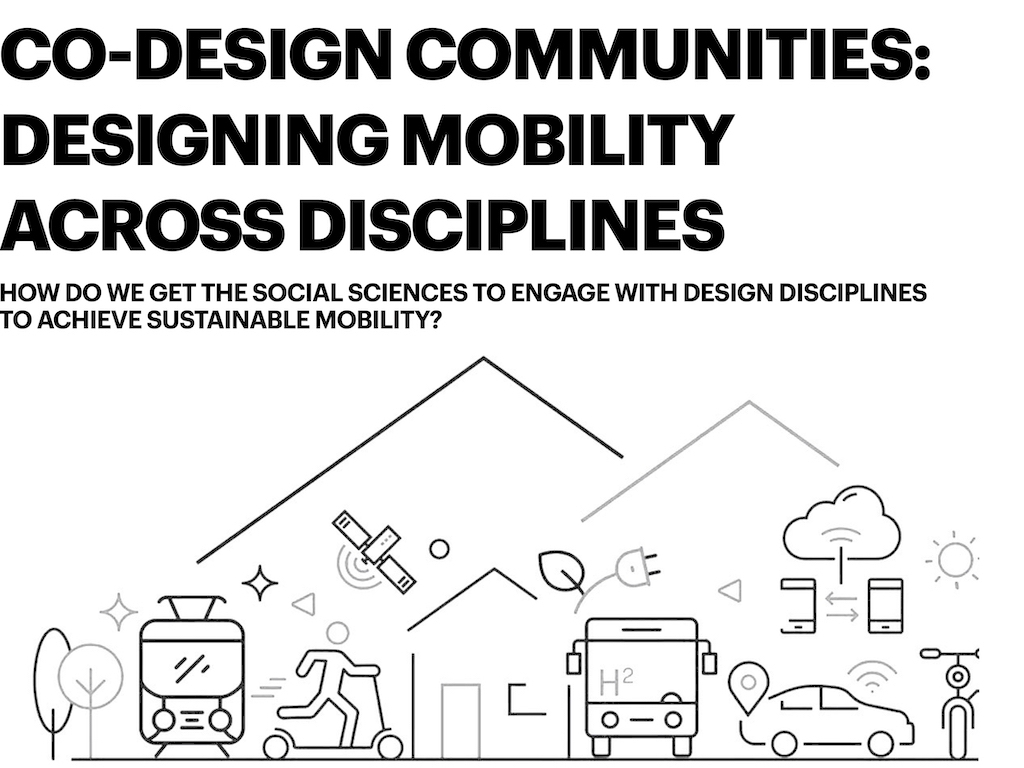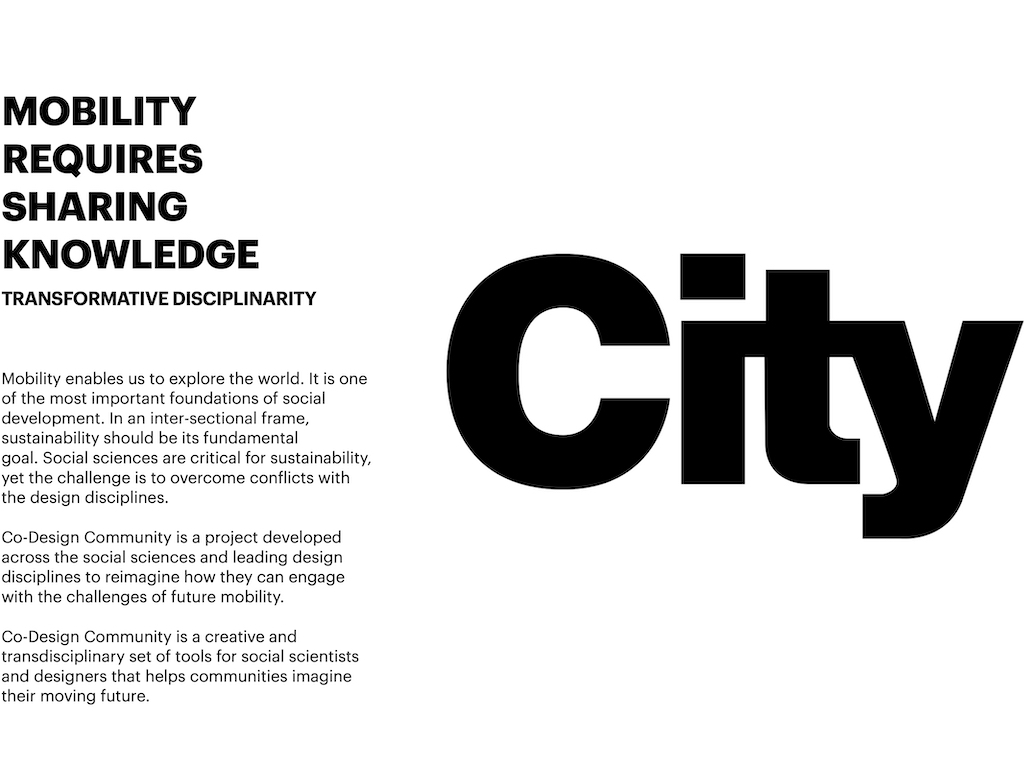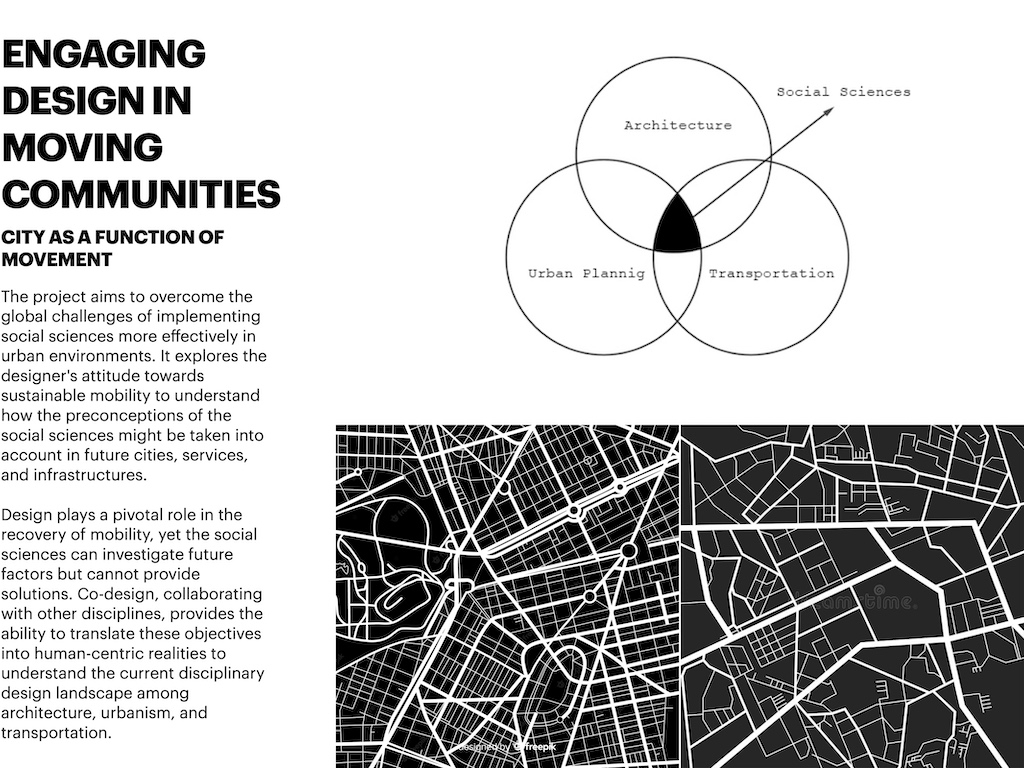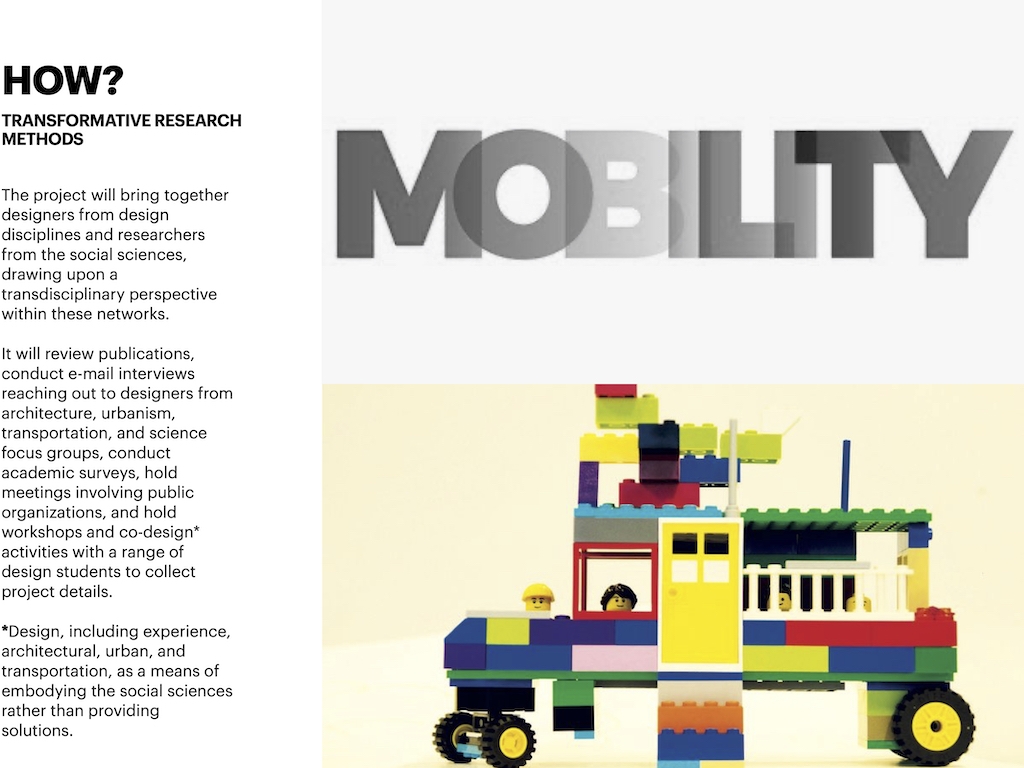COURSE
CHANGING SOCIETIES
University of Basel, Urban Studies, MA Critical Urbanisms, Spring 2023
Basil Bornemann, Claske Dijkema, Jamie Pring, Katrin Sontag
MA Critical Urbanism-University of Basel
MA Critical Urbanisms - Instagram
CO-DESIGN COMMUNITIES
DESIGNING MOBILITY ACROSS DISCIPLINES
Prepared for the Course Assessment







CO-DESIGN COMMUNITIES
HOW DO WE GET THE SOCIAL SCIENCES TO ENGAGE WITH DESIGN DISCIPLINES TO ACHIEVE SUSTAINABLE MOBILITY?
MOBILITY REQUIRES SHARING KNOWLEDGE
TRANSFORMATIVE DISCIPLINARITY
Mobility enables us to explore the world. It is one of the most important foundations of social development. In an inter-sectional frame, sustainability should be its fundamental
goal. Social sciences are critical for sustainability, yet the challenge is to overcome conflicts with the design disciplines.
Co-Design Community is a project developed across the social sciences and leading design disciplines to reimagine how they can engage with the challenges of future mobility.
Co-Design Community is a creative and transdisciplinary set of tools for social scientists and designers that helps communities imagine their moving future.
THE CONTOURS OF FUTURE-ORIENTED PARTICIPATORY
TRANSDISCIPLINARITY IS ESSENTIAL FOR SUSTAINABLE MOBILITY
The current way the design disciplines propose our future with their own parameters is neither promising nor working. They are building more dependent communities and ignoring the importance of sustainability. It is needed to develop an integrated design approach that engages with the social sciences to feed the knowledge of communities back to them.
Getting the social sciences to share their experiments with design disciplines such as architecture, urbanism, and transportation creates challenges for future cities. Sensitivities to designing a sustainable future are relevant to design disciplines in the sense of understanding the dynamics of societies from the individual to the public.
The challenges of sustainable mobility highlight the current stress of an interconnected world, community, and environment. In response to this, designers and researchers should come together to seek a better way forward.
ENGAGING DESIGN IN MOVING COMMUNITIES
CITY AS A FUNCTION OF MOVEMENT
The project aims to overcome the global challenges of implementing social sciences more effectively in urban environments. It explores the designer's attitude towards sustainable mobility to understand how the preconceptions of the social sciences might be taken into account in future cities, services, and infrastructures.
Design plays a pivotal role in the recovery of mobility, yet the social sciences can investigate future factors but cannot provide solutions. Co-design, collaborating with other disciplines, provides the ability to translate these objectives into human-centric realities to understand the current disciplinary design landscape among architecture, urbanism, and transportation.
THE CHALLENGES OF OUR CITIES ARE INTER-SECTIONAL
REINTEGRATING SOCIAL SCIENCES WITH DESIGN DISCIPLINES
Cities are challenged with mobility in various dimensions, and designers are looking to unlock their potential through innovative visions and creative solutions.
The Co-Design Community project builds bridges between designers to come together for one vision and make decisions collectively. This help us understand the joint insight towards future cities and provide tools that might respond to a range of issues for moving societies, including environmental restoration.
Effective solutions can only be offered by reintegrating social sciences with design disciplines.
HOW?
TRANSFORMATIVE RESEARCH METHODS
The project will bring together designers from design disciplines and researchers from the social sciences, drawing upon a transdisciplinary perspective within these networks.
It will review publications, conduct e-mail interviews reaching out to designers from architecture, urbanism, transportation, and science focus groups, conduct academic surveys, hold meetings involving public organizations, and hold workshops and co-design* activities with a range of design students to collect project details.
*Design, including experience, architectural, urban, and transportation, as a means of embodying the social sciences rather than providing solutions.
AND?
HUMAN-CENTRED MOBILITY
We can use this work to understand the role of design in urban environments and how social studies help shape the future of mobility.
We can set out potential paths indicating how the mobility infrastructure might adapt to provide access for every person and offer social, environmental, and economic justice.
We can further explore the research opportunities that arise from this work based on human-centered design.
The research outputs collect insights through the lens of the social sciences, where collaborations between design and social disciplines identify new skill sets for sustainable future mobility.
BIBLIOGRAPHY
Front Commun. (2022) How Does Strategic Communication Shape Transdisciplinary Collaboration? A Focus on Definitions, Audience, Expertise, and Ethical Praxis. Sec. Science and Environmental Communication
Megan O. Matthew P. A. Matthew J. B. Shawn A. C. Wenbo C. Siva P.V. N. (2019) Cohort Learning: Supporting Transdisciplinary Communication and Problem-solving Skills in Graduate STEM Researchers. New Jersey Institute of Technology
Andrzej P. Julia W. R. (2000) The Discipline of Architecture. University of Minnesota Press, Minneapolis
Nigel C. (1982) Design as a Discipline, Designerly Ways of Knowing. Open University, Milton Keynes, Bucks UK
Stalder L. (2019) Things of Modernity. gta Institute, ETH Zurich Research
EPFL Exhibition. (2021) Database, Network, Interface: The Architecture of Information. Available from: https://www.epfl.ch/campus/art-culture/museum- exhibitions/archizoom/database-network-interface-the-architecture-of-information/
Ungers O.M. (2011) Morphologie: City Metaphors. Walther König Press
Urry J. and Sheller M. (2000) The City and the Car. Blackwell Press
Urry J. (2002) Mobility and Connections. Lancaster University
Lefebvre H. (1996) The Right to the City. The Anarchist Library
Kingsley D. and Urry J. (2009) After the Car. Cambridge
Sadler, S. (2005) Archigram. Architecture without Architecture. MIT Press
Gehl J. (2011) Life Between Buildings: Using Public Space. Island Press
Zukin S. (2009) Naked City. Oxford University
Clemens C. (2021) A Future City From The Past. Available from: https://www.clemensgritl.com
Timms, P. and Tight, M. (2014) Constructing Utopias for Future Urban Transport. Uni. of Leeds